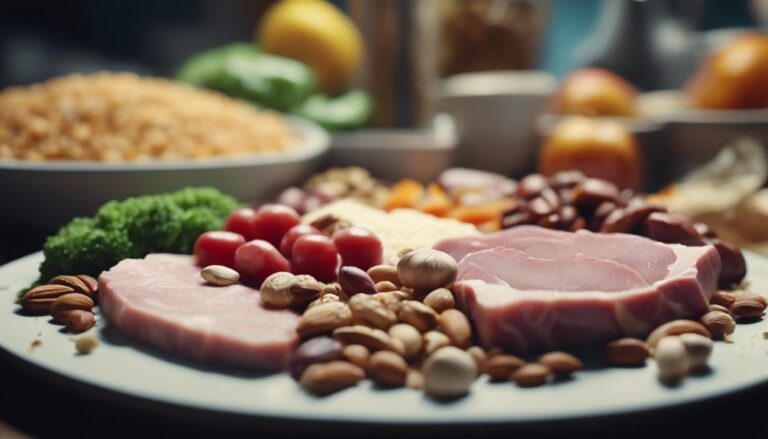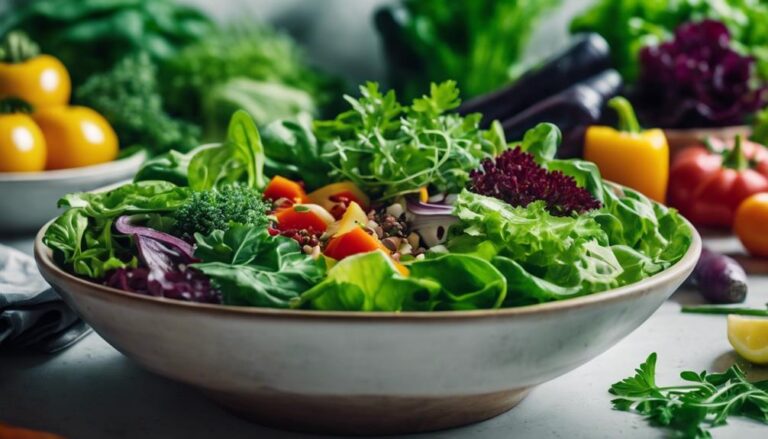Healthy Indian Food
Looking for a cuisine that’s as flavorful as it is nutritious? Look no further than healthy Indian food!
Like a colorful tapestry of flavors, it offers a diverse range of dishes that can satisfy your taste buds and keep you feeling good.
From the health benefits of spices to protein-packed lentil dishes and nutritious vegetarian options, Indian cuisine has something for everyone.
So why not embark on a culinary journey that nourishes both your body and soul?
Spices and Their Health Benefits
Indulge in a variety of spices that offer numerous health benefits when incorporating them into your Indian dishes. Spices not only enhance the flavor of your food but also provide several health benefits. One of the key advantages of using spices is their anti-inflammatory properties. Turmeric, for example, contains a compound called curcumin, which has been shown to reduce inflammation in the body. This can be particularly beneficial for individuals with conditions such as arthritis or inflammatory bowel disease.
In addition to their anti-inflammatory properties, spices can also promote digestive health. Many Indian spices, such as ginger and cumin, have been traditionally used to aid digestion. Ginger, in particular, has been shown to help alleviate symptoms of indigestion and nausea. Cumin, on the other hand, can stimulate the production of digestive enzymes, which can improve overall digestion.
When incorporating spices into your Indian dishes, it’s important to remember that moderation is key. While spices offer health benefits, consuming excessive amounts can lead to digestive discomfort or even irritation. It’s always a good idea to start with small amounts and gradually increase as tolerated.
Nutritious Vegetarian Options
To incorporate nutritious vegetarian options into your Indian meals, explore a variety of plant-based ingredients that can further enhance the health benefits of your dishes. Here are some suggestions:
-
Fiber-rich grain dishes:
Include whole grains like brown rice, quinoa, and millets in your meals. These grains are high in fiber and provide essential nutrients like B vitamins and minerals.
Experiment with traditional Indian dishes like khichdi, made with a combination of lentils and rice, or try upma, a savory dish made with semolina and vegetables. -
Plant-based protein sources:
Legumes such as lentils, chickpeas, and kidney beans are excellent sources of protein. Include them in curries, soups, and salads for a wholesome meal.
Tofu, made from soybeans, is another great option. It’s versatile and can be marinated and added to stir-fries or curries.
These fiber-rich grain dishes and plant-based protein sources not only provide essential nutrients but also help in maintaining a healthy weight and reducing the risk of chronic diseases. Including a variety of these options in your Indian meals ensures a well-balanced vegetarian diet.
Remember to consult a healthcare professional or nutritionist for personalized advice on your dietary needs.
Protein-packed Lentil Dishes
For protein-packed lentil dishes, try incorporating a variety of flavorful legumes into your meals. Lentils aren’t only delicious but also an excellent source of plant-based protein. They’re a staple in Indian cuisine and can be used in a wide range of dishes.
Lentils provide essential amino acids that our bodies need to build and repair tissues. They’re also rich in fiber, which aids in digestion and helps maintain a healthy weight.
When it comes to high protein lentil recipes, there are plenty of options to choose from. One popular dish is dal, a thick and hearty lentil soup seasoned with various spices. Another option is lentil curry, which combines lentils with vegetables and aromatic spices to create a flavorful and nutritious meal.
For a lighter option, you can try a lentil salad with fresh vegetables and a tangy dressing. Lentils can also be used to make patties or burgers, providing a healthy and protein-packed alternative to traditional meat-based options.
Healthy Indian Snacks and Street Food
Try out some nutritious and flavorful options when it comes to healthy Indian snacks and street food. Indian street food is known for its vibrant flavors and unique combinations of spices. While it can be tempting to indulge in greasy and unhealthy options, there are plenty of guilt-free snacking choices available.
Here are a few options to consider for mindful eating and mindful snacking:
-
Healthy Chaat Options:
-
Bhel Puri: Made with puffed rice, vegetables, and tangy chutneys, this popular street food is a light and refreshing snack.
-
Pani Puri: These crispy hollow puris filled with a mixture of flavored water, chickpeas, and potatoes make for a delightful and healthy snack.
-
Nutritious Street Food:
-
Grilled Corn: Roasted on an open flame and seasoned with spices, grilled corn is a delicious and nutritious street food option.
-
Masala Papad: A thin and crispy papad topped with chopped vegetables, spices, and a squeeze of lemon juice, this snack is packed with flavor and nutrients.
When enjoying Indian street food, remember to opt for grilled, roasted, or steamed options instead of fried ones. Additionally, be cautious of the hygiene practices of the vendors to ensure your safety.
With these healthy alternatives, you can satisfy your cravings without compromising your health.
Traditional Ayurvedic Cooking Techniques
To incorporate traditional Ayurvedic cooking techniques into your healthy Indian meals, start by understanding the importance of balancing the six tastes. Ayurveda, an ancient Indian system of medicine and holistic wellness practices, emphasizes the harmony between the mind, body, and spirit. According to Ayurveda, the six tastes – sweet, sour, salty, bitter, pungent, and astringent – play a crucial role in maintaining this balance.
When cooking, aim to include all six tastes in your meals to promote optimal health and well-being. Each taste has specific qualities and affects the body differently. For example, the sweet taste nourishes and provides energy, while the bitter taste helps cleanse and detoxify the body. By incorporating a variety of tastes, you can ensure that your meals are balanced and nourishing.
In traditional Ayurvedic cooking, herbs and spices are also essential. Ayurvedic healing herbs like turmeric, cumin, coriander, and ginger are commonly used for their medicinal properties. These herbs not only add flavor to your dishes but also offer numerous health benefits, such as reducing inflammation and improving digestion.
Additionally, Ayurvedic cooking techniques prioritize the use of fresh, seasonal, and locally sourced ingredients. This ensures that your meals are nutrient-dense and support your body’s natural healing processes.
Tips for Balancing Heat and Flavors in Indian Cuisine
To achieve a well-balanced and flavorful Indian dish, it’s important to consider how to balance heat and flavors. Indian cuisine is known for its bold and spicy flavors, but sometimes the heat can be overwhelming. If you prefer milder dishes, here are some tips for reducing spice levels in your Indian cooking:
-
Use yogurt or coconut milk: These dairy products can help to mellow out the spiciness of a dish. Adding a dollop of yogurt or a splash of coconut milk can provide a creamy and cooling effect.
-
Incorporate fresh ingredients: Fresh herbs like cilantro and mint can add a burst of freshness to your dish and help to balance out the spices. Additionally, adding fresh fruits like mango or pineapple can provide a natural sweetness that can counteract the heat.
When it comes to balancing flavors in Indian cuisine, it’s important to consider the other elements besides spice. Here are a couple of tips to enhance the overall flavor profile:
-
Use whole spices: Toasting whole spices like cumin, coriander, and mustard seeds before using them in your dish can enhance their flavor and aroma. It adds depth and complexity to your dish.
-
Experiment with different cooking techniques: Indian cuisine offers a variety of cooking techniques like tempering, slow cooking, and marinating. Trying out different techniques can help you achieve a well-rounded flavor profile.
Frequently Asked Questions
Are There Any Specific Spices That Can Help With Digestion and Reduce Bloating?
Spices like ginger, cumin, and fennel can aid digestion and reduce bloating. Ayurvedic cooking techniques incorporate these spices for their digestive benefits. Try adding them to your meals for a healthy and soothing effect.
What Are Some Nutritious Vegetarian Options That Are High in Protein?
Looking for nutritious vegetarian options high in protein? Try incorporating healthy vegetarian protein sources into your diet. Indian cuisine offers protein-rich recipes like lentil dal, chickpea curry, and paneer tikka. Enjoy!
Can You Suggest Some Lentil Dishes That Are Not Only High in Protein but Also Low in Fat?
If you’re looking for high protein lentil recipes that are also low in fat, there are many options available. Lentil soups, salads, and curries can be delicious and nutritious choices to incorporate into your diet.
What Are Some Healthy Indian Snacks and Street Food Options That Are Suitable for Weight Loss?
Looking for healthy Indian snacks and street food options? You’re in luck! There are plenty of delicious choices that can aid in weight loss. Let’s explore some of these tasty options.
Are There Any Traditional Ayurvedic Cooking Techniques That Can Be Easily Incorporated Into Daily Cooking Routines?
To incorporate Ayurvedic cooking techniques for a balanced diet, consider using traditional Indian herbs and spices in your everyday meals. These techniques can help you create nutritious and flavorful dishes while promoting overall well-being.
Conclusion
In conclusion, exploring the world of healthy Indian cuisine can be a flavorful and nutritious journey. By incorporating a variety of spices, vegetarian options, lentil dishes, and Ayurvedic cooking techniques, you can enjoy a balanced and satisfying culinary experience.
Don’t forget to indulge in the occasional healthy Indian snack or street food for a taste of tradition. With these tips, you can create harmonious flavors while nourishing your body.






